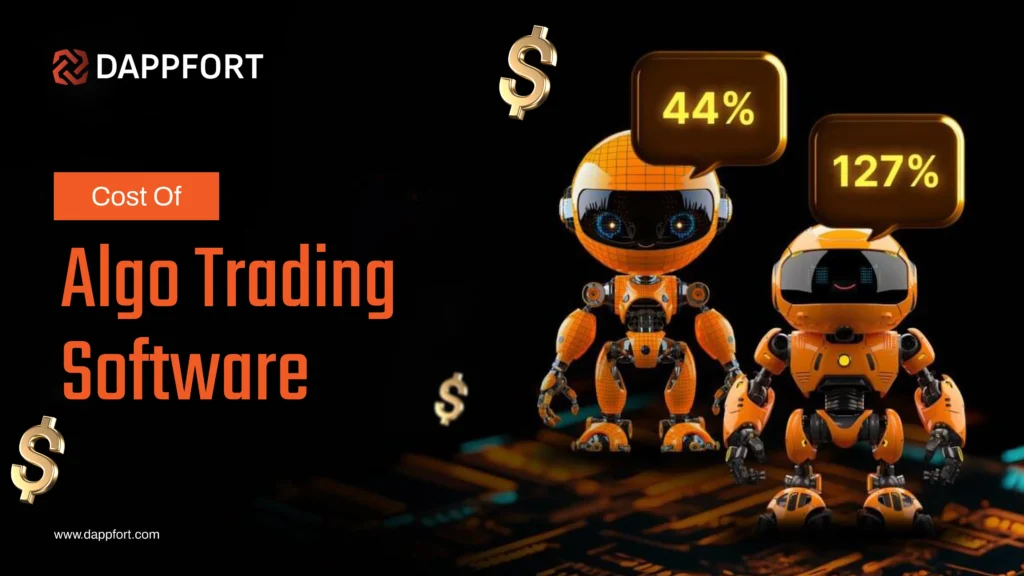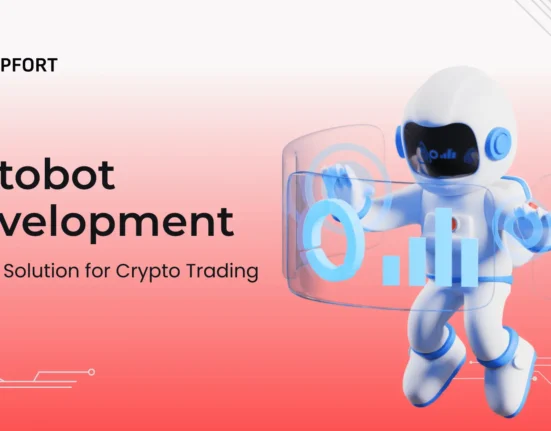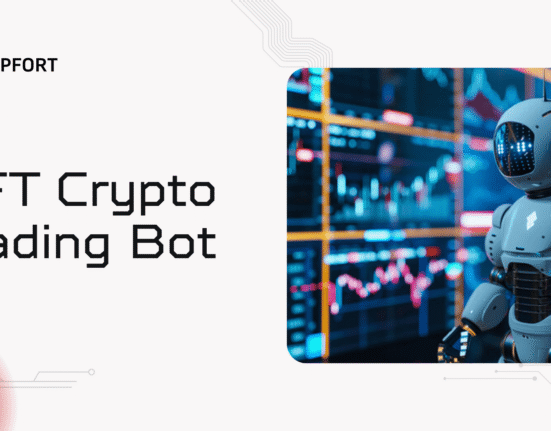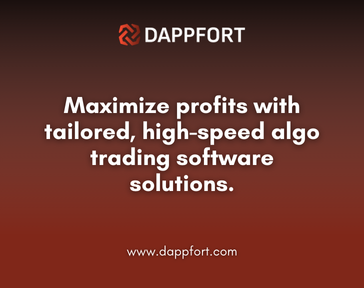Cost of Algo Trading Software – Everything You Should Know Before You Build One

Everyone asks the same thing before they invest — what’s the cost? That’s exactly what we’re unpacking today. Let’s break down the cost of algo trading software, what drives it up or down, and how you can build a high-performing algo exchange within your budget.
You’ll also learn how to reduce your algo exchange cost smartly — without cutting corners on performance or security.
What Is Algo Trading Software?
Algo trading software (algorithmic trading software) is a system that automates the process of trading assets using predefined strategies and mathematical models.
Instead of manually watching charts or entering orders, traders can rely on algorithms to execute trades based on market conditions — often in milliseconds.
It helps in:
- Analyzing live and historical market data
- Detecting patterns and price trends
- Executing buy/sell orders instantly
- Managing risks efficiently
Core features often include backtesting tools, data analytics, real-time order execution, and broker API integration. With a powerful algo exchange, traders can scale operations, minimize emotional trading, and achieve faster, more consistent performance.
Why Businesses Are Moving Toward Algo Exchange
Businesses are moving toward algo software because they open up more trading opportunities, higher profit potential, and faster market access than traditional manual platforms ever could.
Real Numbers: Manual exchanges process ~1,000 orders/second per matching engine. Algo exchanges handle 100,000+ with the same infrastructure cost. That’s a 100x efficiency gain.
Customer Economics: Average algo trader generates 15-20x more fee revenue than manual traders due to higher trade frequency. A platform with 1,000 algo users outearns one with 10,000 casual traders.
Market Reality: 70-80% of equity market volume and 50%+ of crypto volume now comes from algorithmic trading. Platforms without algo capabilities are fighting over a shrinking pool.
Infrastructure Moat: Building reliable algo infrastructure takes 18-24 months and $2-5M. Most competitors can’t copy it quickly, giving first-movers a defendable advantage.
The shift is driven by economics—algo exchanges are simply more profitable and scalable than traditional manual trading platforms.
How Much Does It Cost To Develop An Algo Trading Software?
Here’s the thing — there’s no single price tag. The algo exchange cost depends on how advanced your platform is, the technologies you choose, and the team building it.
The cost of algo trading software typically ranges from $15,000 to $150,000+, depending on scope, tech stack, and features. Let’s break it down stage by stage so you can see where your money goes.
1. Requirement Analysis & Planning
Estimated Cost: $2,000 – $5,000
This is where the blueprint takes shape. Your team defines trading goals, target users, preferred algorithms, and the technical scope of your algo software.
What you get from this phase:
Proper planning keeps the project aligned with business goals, ensures compliance with financial laws, and prevents unexpected cost overruns.
2. Trading Engine Development
Estimated Cost: $10,000 – $40,000
This is the brain of your algo exchange. The trading engine processes market data, executes orders, and manages positions in real time.
What you get from this phase:
Your trading engine directly affects execution speed, accuracy, and system credibility — three factors that define user trust in your platform.
3. User Interface & Admin Dashboard
Estimated Cost: $3,000 – $15,000
A smooth, intuitive interface helps traders easily configure strategies, track performance, and monitor orders. Meanwhile, the admin dashboard gives you visibility over users, trades, and system performance.
What you get from this phase:
A good UI doesn’t just look nice — it makes complex tools usable and increases trader confidence.
4. Broker & Exchange API Integration
Estimated Cost: $2,000 – $15,000
Your algo trading software needs stable API integration with brokers and exchanges to fetch market data and execute live trades.
What you get from this phase:
Without reliable APIs, the entire algo exchange can’t function in real-world trading conditions.
5. Backtesting & Simulation Module
Estimated Cost: $3,000 – $10,000
Before traders go live, they need to test their algorithms on past market data. A backtesting module lets them analyze performance, optimize parameters, and reduce risk.
What you get from this phase:
It gives users confidence that their strategies work before real money is involved.
6. Security & Compliance Framework
Estimated Cost: $2,000 – $7,000
Since your algo software deals with sensitive financial data, building strong encryption, KYC/AML protocols, and secure authentication systems is mandatory.
What you get from this phase:
Security builds trust, while compliance ensures your platform operates legally across regions.
7. Quality Assurance, Testing & Deployment
Estimated Cost: $3,000 – $8,000
Here, the platform is stress-tested, debugged, and deployed to a reliable cloud infrastructure like AWS or Google Cloud.
What you get from this phase:
A stable launch minimizes downtime, ensures smooth performance, and helps attract long-term traders.
8. Post-Launch Maintenance & Support
Estimated Cost: $500 – $2,000/month
Once your algo trading software goes live, ongoing maintenance is crucial — from version updates and security patches to feature upgrades and monitoring.
What you get from this phase:
Regular updates keep your algo exchange optimized, secure, and ready for evolving market conditions.
Regional Impact on Algorithmic Trading Software Price
Your algo trading software development cost also varies based on where your team is located.
- India or Southeast Asia: $15,000 – $60,000
- Eastern Europe: $30,000 – $90,000
- US/UK: $70,000 – $150,000+
Partnering with an experienced offshore fintech team often gives you the best balance between cost of algo trading software and build quality.
Must Have Features Every Algo Trading Platform Needs
When building an algo exchange, the right features can make or break your product’s market performance. Here are the essentials:
Dashboard
Provides real-time insight into active trades, strategies, and performance metrics.
Portfolio Management
Helps users track profits, losses, and overall exposure through a clean and organized interface.
Live Market Data
Delivers continuous, accurate market updates for instant decision-making.
Advanced Trading Functionality
Supports limit, stop-loss, and strategy-based order types for complete control over trades.
Fund Transfer
Secure and simple deposits and withdrawals with trusted payment methods.
Watchlist
Keeps favorite stocks, pairs, or assets in one place for quick access.
Notifications & Alerts
Sends push alerts for price triggers, trade confirmations, and strategy signals.
All of these features impact your algo exchange cost, but they’re essential for building a reliable, trader-focused product.
Tips to Reduce the Cost of Algo Trading Software Development
Building algo trading software doesn’t have to drain your budget. With the right approach, you can balance performance and cost effectively.
1. Start with an MVP
Focus on essential features first. Prove your concept, then scale with real user feedback instead of assumptions.
2. Reuse Reliable Modules
Integrate pre-built APIs or charting tools for faster deployment and lower development hours.
3. Partner with Experts
Collaborate with experienced fintech developers like Dappfort who understand both technology and market logic — it saves time, money, and rework.
4. Skip Unnecessary Complexity
Don’t add every possible feature upfront. Build lean, and evolve with user demand.
5. Use Agile Development
Break development into sprints. It keeps timelines flexible and costs predictable.
6. Plan Maintenance Early
Factor in post-launch updates and bug fixes as part of your initial cost plan.
7. Choose Smart Licensing
Opt for open-source or one-time license tools to avoid recurring platform fees.
Pro Tip: Dappfort’s pre-built algo trading frameworks reduce development time and lower algo exchange cost by up to 40%—without compromising performance or security.
Conclusion
Creating your own algo exchange or algo trading software is a smart move in today’s data-driven trading world — but understanding the real cost of algo trading software is the key to getting it right.
By focusing on smart planning, essential features, and the right development team, you can launch a reliable platform that fits your goals and budget.
Dappfort specializes in designing cost-effective algo software and full-fledged algo exchange platforms tailored to your business model.
Think of it this way: Every dollar you put into your algo software’s engine, connectivity, and security directly impacts your platform’s credibility and trader retention.
Talk to our experts today and get an exact estimate for your project.
Instant Reach Experts:
WhatsApp : 8838534884
Email : sales@dappfort.com


